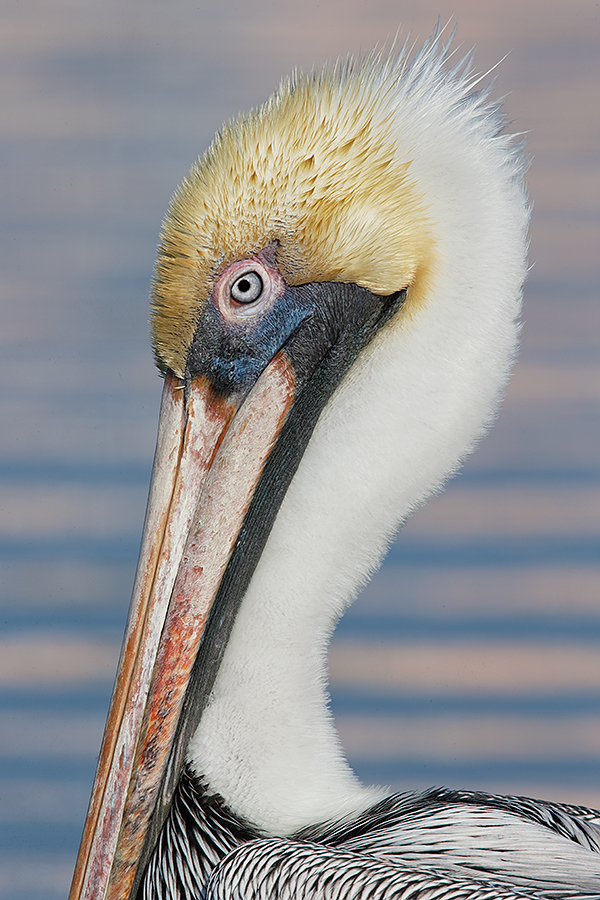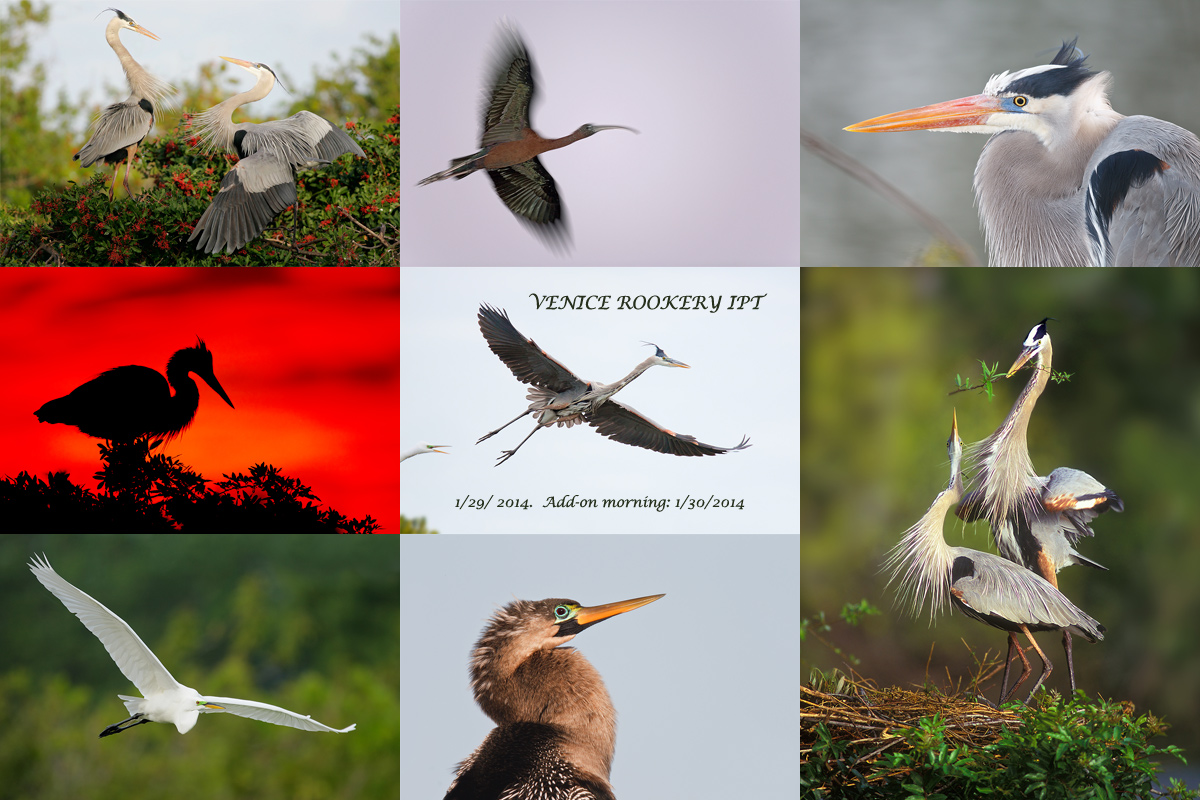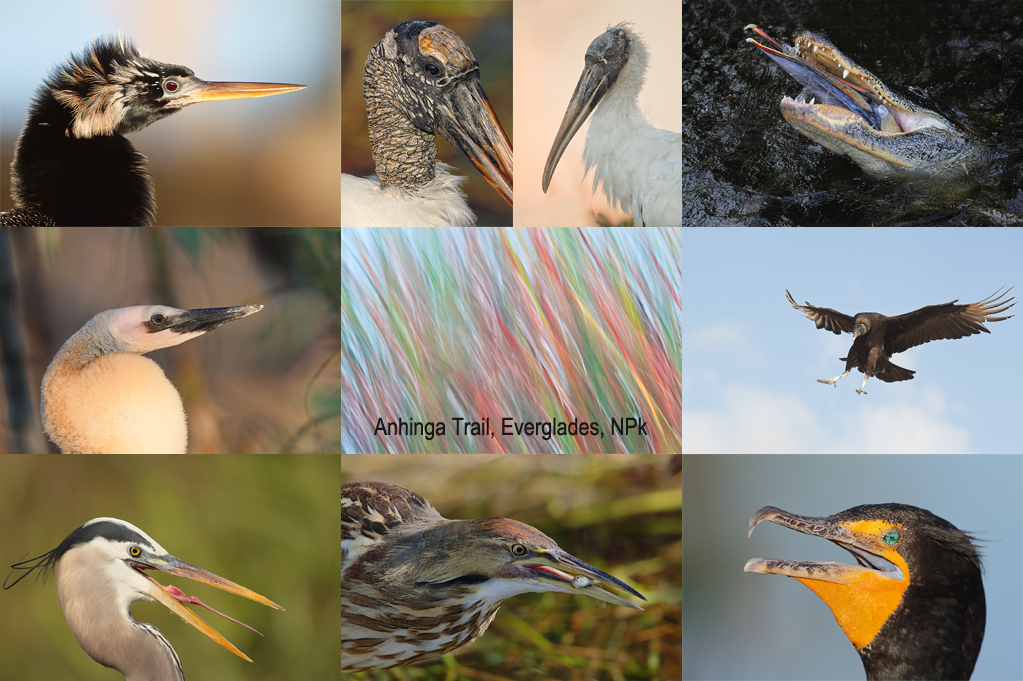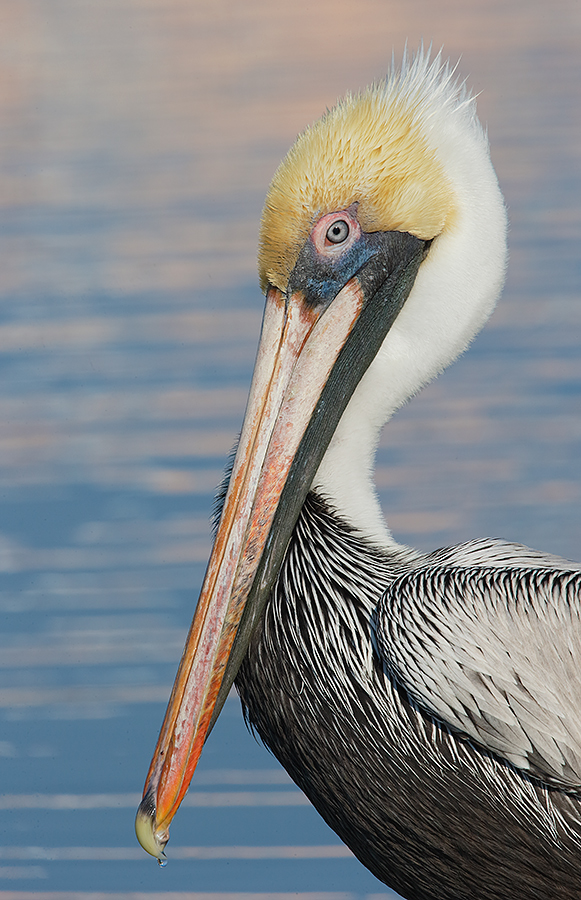And the Streak Goes On
We are up early getting ready for today’s free Birds and Blooms afternoon seminar in Boca Grande, FL. I continue to feel better each day but am far from 100%. This post marks 63 days in a row with a new educational blog post, a record by far that should be extended for at least another week or two. Or not. 🙂 To show your appreciation, we ask that use our B&H and Amazon affiliate links for all of your B&H and Amazon purchases. Please check the availability of all photographic accessories in the BIRDS AS ART Online Store. We sell only what I use and depend on. We will not sell you junk. We know what you need to make creating great images easy and fun. And we are always glad to answer your gear questions via e-mail.
You can find the following items in the store: Gitzo tripods, Mongoose M3.6 and Wimberley heads, plates, low feet, and accessories, flash brackets, , Delkin e-film Pro Compact Flash Cards, LensCoat products, and our unique line-up of educational materials including ABP I & II, Digital Basics, Site and Set-up e-Guides, Canon and Nikon Camera Users and AF e-Guides, and MP-4 Photoshop video tutorials among others.
We would of course appreciate you using our B&H and Amazon affiliate links for all of your B&H and Amazon major gear, video, electronic, household, and personal purchases. For the photographic stuff mentioned above we would of course great appreciate your business.
Thanks and enjoy today’s blog post! This one took only about 1 1/2 hours to assemble.
Less Than 3 Days Left to Enter! BIRDS AS ART 2nd International Bird Photography Competition!
With so many folks signing up at the last minute at the end of December and with so many folks having trouble uploading their images due to server overload, the deadline for entering the contest (registering and paying) was extended just before the end of the last year until January 31, 2014. There will be no additional extensions. The deadline for uploading your images has been extended until midnight Eastern time on February 10, 2014. Take advantage of this extension to have a crack at the great prizes.
Learn more and enter the BIRDS AS ART 2nd International Bird Photography Competition here. Twenty-five great prizes including the $1000 Grand Prize and intense competition. Bring your best.
Register and Pay
To register click here.
To learn of payment options, click here.

|
|
This Brown Pelican image was created on the Little Estero Lagoon IPT with the Gitzo 3532 LS carbon fiber tripod, the Mongoose M3.6 head, the Central sensor (by necessity) Expand/AI Servo/Rear Focus as framed active at the moment of exposure. Click here if you missed the Rear Focus Tutorial. Click on the image to see a larger version.
|
Lesson II On Seeing the Situation and Perspective Choice
It was just before 10:00am yesterday on a dead clear morning. My plan to have everyone in the group create images of the herons and egrets eating live baitfish out of the bucket were wrecked when I caught so many fish in my cast net that all the fish died from lack of oxygen in the water in the bucket. The best laid plans…. There were several pelicans lined up along the shoreline like so many soldiers. I was showing two of the participants with shorter lenses how they could move slowly, choose a good perspective, wait for a good head angle, and create classic vertical pelican head portraits with still blue water backgrounds.
After helping Muriel and Milton, I took my rig and backed up a bit as I was working at 1200mm. When I did so, I noticed the somewhat pink reflections of a distant condo on the eastern shore of the lagoon. In order to utilize those reflections as background I needed to get just a bit lower so again, as I did in yesterday’s post, I pulled out the front leg tab and the the front leg itself on my Gitzo 3530LS tripod. As Denise and I had spent five photography sessions teaching the group the importance of stopping down considerably when working with subjects at point-blank range, I was working at f/20.
After creating the image above, I replaced the 2XIII TC with the 1/4XIII TC, took a few steps back, chose what I thought would be the best perspective, and made a few images.
|
This Brown Pelican image was created on the Little Estero Lagoon IPT with the Gitzo 3532 LS carbon fiber tripod, Mongoose M3.6 head, the Central sensor (by necessity) Expand/AI Servo/Rear Focus as framed active at the moment of exposure. Click here if you missed the Rear Focus Tutorial. Click on the image to see a larger version.
|
The Big Secret
Some folks show up at IPTs hoping to learn the single big secret that will make them a better nature photographer. My answer, as you have seen here in this and the last post, and probably in many dozens if not hundreds of posts here, is that the single biggest secret in creating great images is attention to small detail. An inch to the right here, a step closer there, 1/3 stop more light now, a smaller aperture then. Learning to pay attention to all the little stuff is the key to photographic success.
Image Questions
What do you like about Image #1?
What do you like about Image #2?
Which image has the more pleasing background?
Which image has a more pleasing head angle?
Which image do you like the best. Be sure to let us know why?

|
|
This afternoon seminar is 100% free and open to the public. |
Free Afternoon Seminar Today!
Join Denise Ippolito and me on the afternoon of January 28, 2014 at 1:00pm in the Boca Grande Community Center for a free two-part nature photography seminar entitled “Birds and Blooms.” At 1:00pm I will be presenting “A Bird Photographer’s Story” (updated with lots of my favorite new images). Denise will follow with her hugely popular “Bloomin’ Ideas.” The venue is located at 131 First Street West, Boca Grande, FL 33921.
Suggestion
Join us for the free seminar and then for the Venice Rookery IPT the following day. See below for details.

|
|
Do join us on the Venice Rookery IPT, or better yet, for the whole South Florida Composite IPT. Scroll down or click here for complete details. |
The South Florida Composite IPT
Do consider joining us for one of the remaining parts or all of the South Florida Composite IPT. Call me on my cell at 863-221-2372 or e-mail to learn of the Late Registration Discounts for both the segments and the complete trip. If you call the cell and I do not pick up, please let a message and please be sure to e-mail me a good callback number and time.
Jan 29 (WED): Venice Rookery In-the-Field: all day: (Limit 12/Openings 8): $399. Introductory slide program 7pm, Jan 28.
30 (THURS) -Venice am only. (Limit 12/Openings 7): $249
You can sign up for one or more of the short IPTs and/or one or more of the add-on days or you can opt to sign up for the all the sessions. Those signing up for the whole shebang will be having all lunches and dinners with us most every day. Call us at 863-692-0906 or e-mail to learn of the Late Registration Discounts for both the segments and the complete trip.

|
|
Bird Photography Hotspot: Anhinga Trail, Everglades National Park. Learn more here. |
Anhinga Trail/Everglades National Park Mini-IPT: Feb 1-2, (SAT/SUN), 2014. (Limit 12/Openings 5): $799. Introductory slide program: 7pm: FRI Jan 31. (Limit 12/Openings: 6):
Join Denise Ippolito and Arthur Morris for four great photography sessions at one of the top bird photography hotspots in North America. Morning sessions: 6:15am to 10:30am. Afternoon sessions: 3:00pm till 5:45pm. Lunch included. Informal image review and Photoshop sessions after lunch.
Jan 31 (Friday) Anhinga Trail/Everglades National Park Optional Add-on/Morning Only (Limit 12/Openings 5): $249
Includes lunch, and informal image review and Photoshop session. Call us at 863-692-0906 or e-mail to learn of the Late Registration Discounts for both the segments and the complete trip.
Because of our intense travel schedule that includes a trip to Japan I will not be running the traditional SW FLA IPT. In addition, in an effort to give some folks a chance to get a taste of our teaching and our passion for bird photography, Denise Ippolito and I have organized a series of short IPTs that may be combined into one wonderful experience or enjoyed piecemeal. Click here for complete details or to register. Please e-mail with any questions or leave a comment below.
A $500 non-refundable deposit is required to hold your slot for this IPT. For the short segments that are less than $500 payment in full is due at the time of registration. Your balance is due 4 months before the date of the IPT and is also non-refundable. If the trip fills, we will be glad to apply a credit applicable to a future IPT for the full amount less a $100 processing fee. If we do not receive your check for the balance on or before the due date we will try to fill your spot from the waiting list. If your spot is filled, you will lose your deposit. If not, you can secure your spot by paying your balance. Best to call Jim or Jennifer with a credit card in hand to register. Credit cards are not accepted for balances. Alternatively you can send a check for $500 made out to Arthur Morris to us at PO Box 7245, Indian Lake Estates, FL, 33855. Please include a note with your e-mail address and be sure to let us know what you are signing up for.
Support the BAA Blog. Support the BAA Bulletins: Shop B&H here!
We want and need to keep providing you with the latest free information, photography and Photoshop lessons, and all manner of related information. Show your appreciation by making your purchases immediately after clicking on any of our B&H or Amazon Affiliate links in this blog post. Remember, B&H ain’t just photography!




Amazon
Everyone buys something from Amazon, be it a big lens or deodorant. Support the blog by starting your search by clicking on the logo-link below. No purchase is too small to be appreciated; they all add up. Why make it a habit? Because I make it a habit of bringing you new images and information on an almost daily basis.
Typos
In all blog posts and Bulletins, feel free to e-mail or to leave a comment regarding any typos, wrong words, misspellings, omissions, or grammatical errors. Just be right. 🙂
IPT Info
Many of our great trips are filling up. See especially info on the South Florida, Holland, and Nickerson Beach IPTs. Two great leaders on most trips ensure that you will receive individual attention, have all of your questions answered, and learn a ton including how to think like a pro, see the situation, and get the right exposure every time. In addition you will have fun, and make lots of great images. Click here for IPT details and general information.

















image 1 makes you focus in more closely on the eye of the subject. I like it.
I prefer #2 because of the water drop on the bill and the background looks more natural to me.
Enjoy the Anhinga trail. I was there ten days ago. Had one phenomenal shooting day (including purple gallinule) and another with very little due to high winds. The vultures devoured a rubber gasket on top of my new vehicle. 🙂
I love the tighter crop here as the background sings! Great job as always Mr. Morris!
I like number 1 for the detail and and the eye being the major focal point.. I like number 2 again for the sharp detail but also for the entire bill with the small drop of water at the end. The background for number 2 is more pleasing as I don’t like the horizontal lines in the water in number 1. As for head angle I can see a small difference between the two of them, but I like both of them. I will wait for your reply as to which one is better. As to which one I like better I will go with number 2. I wonder what it would look like if the small amount of feathers by the bill were not there. My favorite one would be number one with number 2’s background. The more I look at number 1 the more I like the emphasis on the eye; the background is really different and not often seen, but it doesn’t work for me.
Hi Arthur.
I like # 2 the best because we see all of the bill with the drop of water and the pelican’s eye is looking right at you. Photo #1 to me is too tight, but I really like the background slightly better than #2. Sharpness is excellent, Head angles on both do not bother me. Both are great shots, but #2 is the one I like the best.
What do you like about Image #1? There’s two things I like about this one. One are the
horizontal lines that make up the background. The second is, the beak laying right on
the body (in other words, its not intersecting anywhere).
What do you like about Image #2? Nothing really specific, I just love the image as a whole.
Which image has the more pleasing background? I love #1 cause of the horizontal lines and how
the colors resemble the colors around the eyes.
Which image has a more pleasing head angle? Tough one cause #2 is more towards the camera, but
that small patch of feathers sticking out from behind the beak kinda bugs me…vs #1 which seems
a little more parallel to the plane, but everything about the bird lining up is what I love.
Doug
Which image do you like the best. Be sure to let us know why?
I should have stated both images are extremely sharp, but because of the subject be larger in image #1, the sharpness is more apparent. image #1 is my favorite!!
I should have stated both images are extremely sharp, but because of the subject be larger in image #1, the sharpness is more apparent.
I like image#2 because I can see the entire bill with the added bonus of the water droplet.
I like image#1 because of the amazing detail due to the extreme sharpness and #1 also has a much more pleasing background. Head angle, to me, is a draw.
Greetings Artie!
This response comes to you from Ice Station Zebra (aka Minneapolis where it is -19 degrees/windchill of -35 degrees!). I am glad to see with each post lately that you are feeling better and better and more yourself. I prefer image #2 overall. I find the banded nature of the background in image #1 too distracting however I like the head angle and intense detail rendered. I find the softer, pastel background of image #2 more pleasing and think the framing is perfect for a vertical portrait. The water drop on the end of the beak is a bonus element of interest. Though the head angle is a few degrees more toward the camera than ideal in image #2 I still find overall this image works better for me. The detail in both images is superb. Continued success on your Florida Composite IPT and say hey to Denise, too 🙂
Best regards and return to great health,
Dave